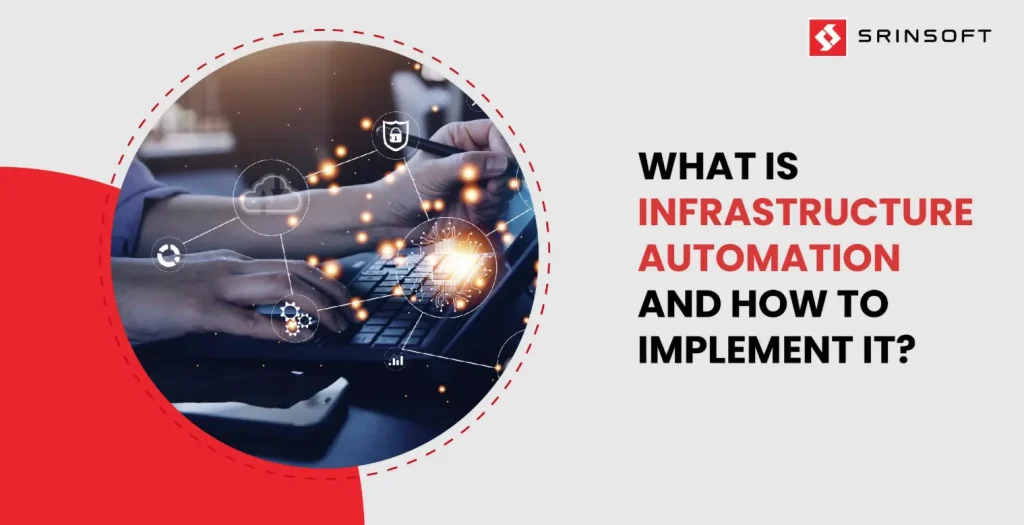
Businesses in recent times are dealing with tech infrastructures that are becoming more sophisticated and massive, as they are required to manage enormous amounts of data, applications, and new digital devices.
With this level of complexity, every part of the tech infrastructure must be automated — from installation to any long-term maintenance requirements, for better efficiency. Manually provisioning and configuring systems in such an environment is slow and error-prone. This can produce inefficiencies in the system and possibly downtime.
To address these challenges, organizations are implementing Infrastructure Automation (IA) which focuses on making IT operations more efficient and less prone to errors that generally take place in manual processes.
By taking advantage of infrastructure automation, IT teams can concentrate on strategic activities instead of doing repetitive and time-consuming tasks – optimizing their daily operations and creating a more productive environment.
Let us dive deeper to understand more about infrastructure automation, its importance, and the methodology for organizations to get started with IA.
Table of Contents
ToggleWhat is Infrastructure Automation and its Importance?
Infrastructure automation employs software, scripts, and tools to manage IT infrastructure with as little human intervention as possible. This revolves around the automated execution and coordination of tasks such as server setup, network configuration, storage management and application deployment.
Infrastructure automation is very important for all kinds of modern IT architectures such as microservices and monolithic applications. IA makes it easier to set up environments quickly and reliably for development, testing, and production.
Automation tools make workload deployment even more efficient in cloud environments. They optimize the way resources are used and save costs by automatically handling tasks such as terminating unused virtual machines and reclaiming unnecessary storage.
IA can automatically handle network configurations so that the security policies are applied consistently throughout the organization’s infrastructure. Automated deployments guarantee that security measures are carried out accurately each time they are deployed, safeguarding against the possibility of errors due to manual processes.
A simple example is a script that automatically uploads security patches to the servers and provides them with regular updates. It ensures that the servers are always up-to-date without manual intervention.
IA can also keep up with checking security standards and fix if found faulty. This can significantly speed up the deployment of necessary patches in particular. It allows updates to take place faster and plug vulnerabilities quicker thereby achieving high security.
Explore our Middleware Automation ->
Benefits of Infrastructure Automation
By embracing infrastructure automation, businesses can have several advantages in their operations. Let us delve deeper into the benefits that can be reaped from implementing IA.
Cost Reductions in Infrastructure Automation
Automating routine tasks reduces the need for manual labor. This helps cut down labor costs without affecting the quality of IT operations. Consequently, IT staff can focus on strategic projects instead of repetitive tasks.
Improved Efficiency and Accuracy
Automation ensures workflows are deployed based on a central policy repository. This improves workflow efficiency and accuracy because it minimizes errors and ensures consistent processes throughout the organization.
Increased Agility in Infrastructure Automation
IA provides better visibility into operations which enables quick responses to changes and challenges. It helps businesses scale operations to meet growth demands and adapt to new market conditions.
Consistent Security and Compliance
Businesses can maintain uniform security policies across multi-cloud environments by automating routine security checks and compliance verifications. This reduces the risk of security breaches and ensures regulatory standards are met.
Provisioning Efficiency
Infrastructure Automation speeds up the process of provisioning new resources, like virtual machines and network components. By implementing IA, what used to take weeks can be done in minutes. This is especially valuable in multi-cloud and hybrid IT environments.
How to plan the capacity in Infrastructure Automation
Automated systems identify under and over-provisioning of resources. This ensures optimal resource allocation and improves performance and reduces waste by using resources efficiently.
Reduced Human Error
Automating repetitive and complex tasks minimizes the likelihood of human error. This enhances security and makes infrastructure management more reliable and consistent.
Enhanced Workflows
Automation allows for repeatable and accurate IT provisioning processes. Operations teams set conditions for infrastructure provisioning while automation tools execute these tasks, ensuring smooth and predictable workflows.
Scalability and Flexibility
Infrastructure automation accommodates business growth and changing needs without extensive manual adjustments. This flexibility ensures that IT infrastructure evolves with organizational goals.
Real-Time Monitoring and Management
When systems are automated, they can provide real-time updates and monitoring. This enables IT teams to identify and resolve issues quickly as well as ensure better control over infrastructure performance.
Future-Proofing
Automation manages both traditional and cloud-native workloads across various environments. This keeps the infrastructure robust and adaptable to future technological advancements.
Real-World Instances of Infrastructure Automation in Action
Now that we know more about infrastructure automation and its benefits, let us look at some of the real-world use cases where companies leverage IA in their operations.
Streaming Platforms
Streaming platforms, like Netflix and Hotstar, use infrastructure automation to handle their vast streaming service. By automating server management and scaling, these companies can quickly adapt to millions of viewers, ensuring smooth streaming without downtime. This automation also helps them deploy updates and new features faster, enhancing user experience.
E-Commerce
Companies like Walmart and Amazon leverage infrastructure automation to streamline their e-commerce operations. Automated systems manage inventory, deal with peak shopping times, and guarantee website stability. This automation improves efficiency, drives down costs, and provides a consistent customer shopping experience by improving the availability and performance of the website.
How Infrastructure Automation helps in transport
Ride-hailing apps like Uber utilize infrastructure automation to manage their platform. Automated processes handle real-time data processing, surge pricing, and routing algorithms. This guarantees the best possible service to drivers and riders while not only keeping the whole system up and running but also doing it with good efficiency.
How to Identify Processes Eligible for Automation
Organizations that are looking to optimize operations and improve efficiency will have to decide which IT infrastructure processes to automate. Following are some of the crucial steps involved in identifying the processes that can benefit the most from automation.
Evaluate Repetitive and High-Volume Tasks
The first step is to look for tasks that are done repeatedly, like routine maintenance, applying patches, and making backups. These are ideal for automation. Additionally, find high-volume tasks that take up a lot of time and resources. Automating these can save a lot of time and allow your IT team to work on more important projects.
Analyze Time-Consuming Processes
Identify processes that take a lot of time and slow down your projects, like setting up servers, configuring networks, and deploying applications. Automating these tasks can make them much faster, boost productivity, and speed up project completion.
Consider Error-Prone Tasks
Human error is a common issue in manual processes. It becomes important to identify manual tasks (like setting configurations and pushing updates) that often lead to errors and can even cause system downtime, security problems, and data loss. Automating these tasks can help minimize mistakes, making processes more reliable and consistent.
Assess the Frequency of Incidents and Failures
Find areas where problems occur frequently and look at how often failures happen in your IT processes. Tasks that need constant troubleshooting are good candidates for automation. For instance, automating processes like monitoring system health, managing logs, and responding to incidents can help detect and fix problems in real-time. This reduces downtime and improves system reliability.
Evaluate Complexity and Dependency
Processes like setting up new environments or connecting different software systems have complicated workflows or dependencies on other tasks. It is essential to identify such complicated tasks and use automation tools to handle these complex workflows efficiently. By using this approach you can ensure that all dependencies are managed well and processes run smoothly.
Identify Bottlenecks and Pain Points in Infrastructure Automation
As a prerequisite to automation, you should identify manual processes that are slowing down operations or causing major problems. Brainstorm with your IT team to find bottlenecks and pain points in your processes. Focus on automating these areas to improve the performance and efficiency of your IT infrastructure.
Leverage Infrastructure Automation Tools and Technologies
To make the most out of the automation tools, it is essential to first check for tools that can be integrated with your current IT infrastructure. Choose tools that are easy for your team to learn and use as well as those that can be scalable and handle increased workloads.
Look for tools that offer a range of automation features like configuration management, orchestration, and monitoring. These tools can help streamline various processes and improve overall efficiency.
By carefully assessing all the above factors, you can determine which parts of your IT infrastructure are ideal for automation. This approach will help you improve efficiency, reduce errors, and boost system performance, which together readies your organization for success.
Conclusion
Infrastructure automation is at the core of managing modern IT environments. IA accelerates the deployment process, minimizes errors, and lets IT teams concentrate on essential activities such as innovation and productivity. Nevertheless, achieving infrastructure automation is not always straightforward. Implementation of IA can face impediments like resistance to change, lack of qualified staff, and upfront installation costs.
Organizations can emerge out of these challenges by investing in training programs, phased steps to automation, and strategic partnerships with vendors. By having a robust strategy in place, businesses can fully harness the benefits of infrastructure automation and ensure they remain competitive and agile.
FAQs
1. What is the most popular tool that is used for infrastructure automation?
Jenkins, Ansible, Puppet, Docker, and Kubernetes are some of the popular infrastructure automation tools.
2. Can RPA be used for automating infrastructure operations?
With the right solutions, robotic process automation (RPA) for infrastructure in corporate IT settings is a robust solution for enhancing service management within a firm.
3. What IT infrastructure processes can be automated?
Configuration and System maintenance. Automation gives you predictable and repeatable processes for managing configurations across operating systems. It also helps teams manage large, complex IT infrastructures with their current staff.
4. What is cloud infrastructure automation?
Cloud automation refers to the implementation of tools and processes to reduce the manual intervention associated with provisioning, configuring, and managing public, private, and hybrid cloud environments.
5. Is infrastructure as code an automation?
Infrastructure as code (IaC) is used for infrastructure automation to create environments. The most common use of IaC is in software development to build, test, and deploy applications. Traditionally, system administrators used a combination of scripts and manual processes to set up infrastructure environments.



